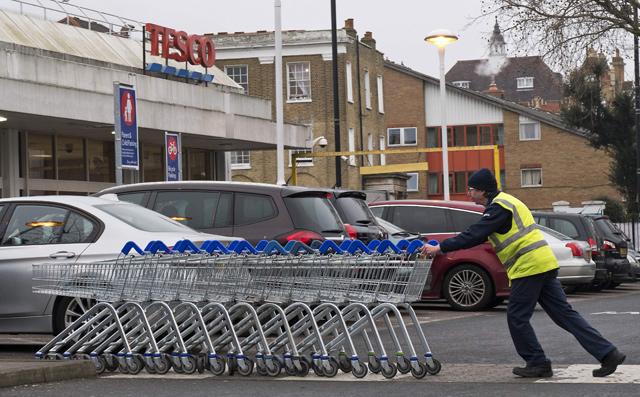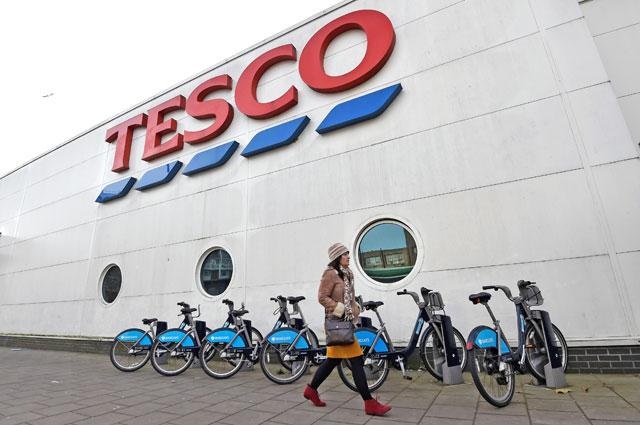You are here
Tesco profits jump as Britons keep spending despite ‘Brexit fatigue’
By Reuters - Apr 11,2019 - Last updated at Apr 11,2019

In this file photo taken on January 9, 2018, a worker pushes a line of trolleys in the car park at a branch of Tesco in south London (AFP photo)
LONDON — Britons have carried on spending despite their “Brexit fatigue”, Tesco said on Wednesday, as a forecast-beating rise in profit confirmed a turnaround at Britain’s biggest retailer.
Celebrating its 100th year, Tesco is deep into a recovery plan under Chief Executive Dave Lewis after a 2014 accounting scandal capped a dramatic downturn in its fortunes.
“After four years we have met or are about to meet the vast majority of our turnaround goals,” the former Unilever executive said. “I’m very confident that we will finish the job this year.”
The 2018-19 results reflected revamped relationships with suppliers, lower prices versus major competitors, simplified and better quality product ranges and improved store standards.
Lewis said customers had responded well to the company’s “Exclusively at Tesco” brands, with 84 per cent of them trying the products.
The improvements have helped Tesco steer a steady course through a period of industry turmoil, as the country prepares to leave the European Union and as Tesco’s two biggest competitors try to merge to become the new industry number one.
Lewis said almost every assumption made when he set recovery targets had been up-ended by events such as Brexit, which has caused the pound to fall and a deepening political crisis.
Customers were suffering “Brexit fatigue”, Lewis said, but were not changing their shopping habits or stockpiling.
“We’ve not seen any softening [in consumer confidence],” he told reporters. “We’ve not seen any discernable change in buying behaviour through the fourth quarter or indeed into the early part of this year.”
Brexit contingencies
Shares in Tesco, which have risen by nearly a quarter this year and reached a six-month high on Tuesday, were up 0.8 per cent at 235.87 pence at 09:40 GMT.
Russ Mould, investment director at AJ Bell, said Lewis had “delivered the goods”.
“The core grocery business is ticking along nicely, profitability has improved markedly and the prospective threat from an Asda-Sainsbury combination is receding in the face of regulatory opposition,” he said.
Tesco has a leading 27.4 per cent share of Britain’s grocery market, according to the latest industry data, and looks set to retain that place after the competition regulator said in February it was minded to block Sainsbury’s ($9.6 billion) takeover of Walmart’s Asda.
While Brexit was not impacting customers, the effects were being seen on Tesco’s balance sheet as steps to secure supplies hit working capital.
“We have been proactive where we can in taking some provision if there were to be a difficulty; that impacts on the timing of the working capital in the business,” Lewis said.
“It’s dry, non-perishable items where it’s possible for our ourselves or our suppliers to hold stock.”
Analysts at Bernstein said full-year retail free cash of £906 million fell short of its £1.22 billion target due to the timing of receivables and Brexit-related stock building, but a lot of that would reverse.
Aside from working capital, Tesco beat market forecasts for profit, and was firmly on track to meet its margin goals.
Operating profit jumped 34 per cent to £2.21 billion ($2.89 billion) for the year ended February 23, while the company declared a dividend of 5.77 pence per share, up 92 per cent.
Group sales rose 11.5 per cent to £56.9 billion and Tesco recorded its 13th quarter of like-for-like sales growth in its main UK market with a 1.7 per cent rise in the final quarter.
The operating profit margin was 3.79 per cent in the second half, excluding Tesco’s acquisition of wholesaler Booker, Lewis said, “comfortably within” the 3.5-4 per cent target range set for this financial year.
Related Articles
LONDON — Britain's supermarket chain Sainsbury on Saturday said it was in talks to merge with rival Asda, in a deal that would create a reta
LONDON — Tesco won provisional approval for its £3.7 billion ($4.9 billion) takeover of wholesaler Booker from the UK competition regulator
LONDON — Britain's biggest retailer Tesco has recruited more than 45,000 staff in two weeks, largely to cover supermarket workers affected b



















